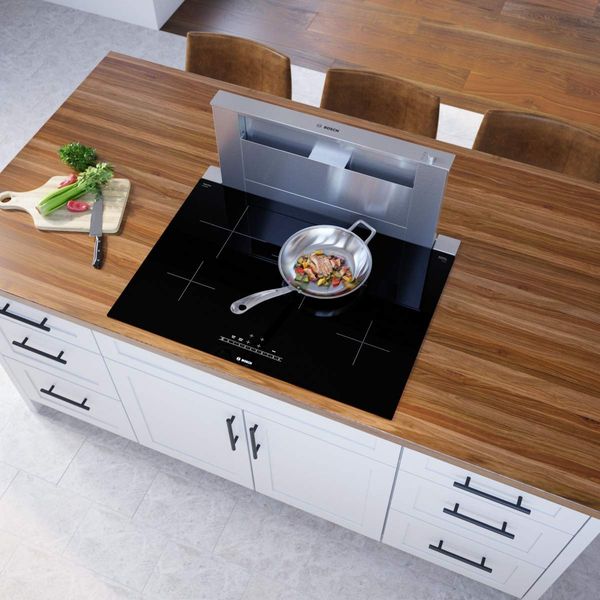
Choosing the wrong cooktop can seriously impact your cooking routine, not to mention raise your energy bills.
If you're looking for an energy-efficient electric cooktop, your two main options are radiant and induction. While both offer sleek, modern designs, they work very differently and come with their own pros and cons.
In this guide, we break down induction vs. radiant cooktops to help you find the best fit for your kitchen. We cover how each type works, real-world performance examples, energy efficiency, cost comparisons, and which cookware is compatible.
Cooking Speed: Induction vs Radiant Compared
The speed of induction vs radiant cooking is dramatic when tested side by side. An induction cooktop uses electromagnetic energy to heat the cookware directly, so a pot of water boils in approximately 90 seconds.
So, what is a radiant stove? Well, a radiant heat cooktop relies on metal coils beneath a glass surface, which first heats the glass, then the pot, which can take 6 to 7 minutes to reach a boil.
This difference matters when cooking everyday meals. For example, boiling pasta is significantly faster on induction because it reduces prep time. Induction also excels at quickly reducing sauces to a simmer, thanks to its precise control.
While radiant burners glow red-hot and remain hot for a long time after use, induction surfaces stay cool to the touch, as only the pan gets hot. This speed and efficiency make induction ideal for time-sensitive tasks, so it's a clear performance advantage in the induction vs radiant cooktop cooking speed.
Induction Needs Magnetic Cookware—Radiant Doesn’t
Induction cooking requires pots and pans made from magnetic materials like cast iron or certain stainless steels. A quick way to check at home is the magnet test. If a magnet sticks firmly to the bottom, it’s induction-compatible. In contrast, a radiant cooktop works with any flat-bottomed cookware, including aluminum, copper, and glass.
Additionally, induction gives you enhanced safety features. Burners stay cool since only the cookware heats, and most models include auto shut-off and child locks. A key feature is that induction pauses instantly if a pan is lifted, then resumes when it’s placed back.
These features aren’t possible with radiant systems, which continue heating the glass surface. If choosing between an induction or radiant cooktop, consider not only cookware compatibility but also the advanced safety and energy control features induction provides.
Which Cooktop Saves You More Over Time?
The energy efficiency difference between an induction and vs radiant cooktop can impact long-term costs. Induction systems transfer around 85–90% of their energy directly to the pan, while radiant models average just 65–70% efficiency due to heat loss through the glass surface.
Though induction cooktops can cost $200–$500 more upfront, they use less power overall. A typical induction burner may use 1.4 to 3.7 kW, depending on the setting, while radiant models range from 1.2 to 3.0 kW. If you cook daily, induction could lower your monthly electricity bill by $5–$10.
Over several years, that adds up. Some utility companies give you rebates for energy-efficient appliances, including induction ranges. If you're investing in a high-end electric range top, induction models not only cook faster and safer but also provide better efficiency. These savings, combined with rebates, can offset the initial cost and make induction a more economical option in the long run.
Side-by-Side: Induction vs Radiant Cooktop
When comparing an induction vs radiant cooktop, this table highlights why many households are choosing induction for long-term energy savings and safety.
| Feature | Induction Cooktop | Radiant Cooktop |
|---|---|---|
| Heating Method | Electromagnetic energy heats the pan directly | Electric coils heat glass surface, which transfers heat to pan |
| Boil Time (1 qt. water) | ~90 seconds | 6–7 minutes |
| Surface Temperature | Stays cool (only pan heats) | Surface gets red-hot |
| Cookware Requirements | Magnetic (cast iron, some stainless steel) | Any flat-bottomed cookware |
| Pan Detection | Pauses instantly when the pan is removed | Continues heating even if the pan is lifted |
| Energy Efficiency | ~85–90% | ~65–70% |
| Power Usage | 1.4–3.7 kW depending on the setting | 1.2–3.0 kW depending on the burner |
| Safety Features | Auto shut-off, cool surface, child lock | Hot surface indicator only |
| Upfront Cost | $200–$500 more than radiant | Lower initial price |
| Long-Term Savings | Lower monthly energy bills; rebates often available | Higher long-term electricity use |
| Appliance Availability | Common in modern high-end electric range models | Found in many standard and budget electric models |
Radiant or Induction? Choose from Our Best-Selling Models
If you're looking for the best of these types of electric cooktops, then you've come to the right place. Below are Snow Brothers' most popular cooktop models that homeowners trust.
Frigidaire 36" Black Stainless Steel Electric Cooktop
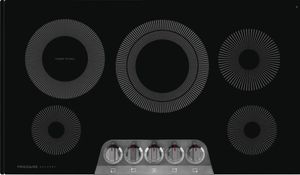
Shop Frigidaire 36" Black Electric Cooktop
Busy kitchens need appliances that can keep up, and this Frigidaire radiant cooktop does exactly that.
Its sleek black stainless steel finish complements modern spaces while delivering consistent heat for everyday meals.
With five versatile elements and smart front controls, it’s ideal for home chefs or families who juggle multiple dishes at once. The ceramic glass surface also makes cleanup a breeze after the cooking is done.
Top Features
- Consistent Cooking Results – EvenTemp Element delivers uniform heat to eliminate hot and cold spots.
- Flexible Heating Zones – Dual Expandable Element adjusts from 9" to 12" to fit different pan sizes.
- Enhanced Safety & Style – LED Backlit Knobs glow when in use, offering better visibility and a modern touch.
Samsung 36" Stainless Steel Electric Cooktop
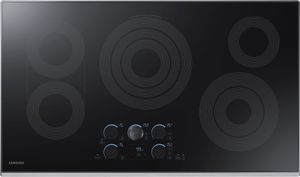
Shop Samsung 36" Stainless Steel Electric Cooktop
Experience precision and convenience with this sleek stainless steel radiant cooktop from Samsung.
Combining digital and analog controls, it offers both intuitive operation and advanced temperature accuracy.
High-output burners and smart syncing features make it a smart pick for busy households and tech-savvy home chefs. Plus, the smooth glass surface enhances modern kitchens and cleans up.
Top Features
- Sync Burners for Oversized Cookware – Control two elements at once to evenly heat large or griddle-style pans.
- Rapid Boil Element – Delivers up to 3.3 kW of power for quick boiling and precise simmer control.
- Smart Connectivity – Built-in Wi-Fi and Bluetooth allow remote monitoring and seamless hood synchronization.
Bosch 800 Series 36" Black Electric Cooktop
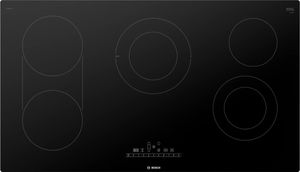
Shop Bosch 800 Series 36" Black Electric Cooktop
Sleek, powerful, and thoughtfully engineered, this Bosch electric cooktop takes everyday cooking to another level.
With ultra-precise controls and 17 power settings, it’s built for home chefs who want accuracy without sacrificing speed.
The black glass design adds a high-end touch, while features like the bridge element make it ideal for families using oversized cookware. It’s a smart pick for multitaskers who value control and a clean, modern look.
Top Features
- SpeedBoost Technology – Cuts heat-up time significantly for faster boiling and high-heat cooking.
- PreciseSelect Control – Offers 17 direct power levels for accurate and responsive temperature adjustments.
- Bridge Element Flexibility – Connects two elements to accommodate long pans, griddles, and specialty cookware.
Electrolux 36" Induction Cooktop
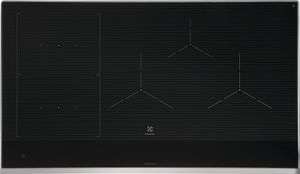
Shop Electrolux 36" Induction Cooktop
Slide a pan across the surface, and this Electrolux induction cooktop does the rest. Designed for responsive control and consistent heat, it’s a standout choice for home chefs who want precision without the hassle.
The modern, flush glass surface blends seamlessly into contemporary kitchens, which makes it a smart fit for design-conscious families.
Ideal for those who entertain or cook often, it combines advanced features with everyday ease.
Top Features
- Precise Temperature Control – Built-in sensors maintain exact pan heat for consistent cooking results.
- Power Slide Function – Automatically adjusts burner temperature as you slide pans between zones.
- Serve Warm Mode – Keeps multiple dishes at the ideal serving temperature until you're ready to eat.
Café 36" Stainless Steel Induction Cooktop
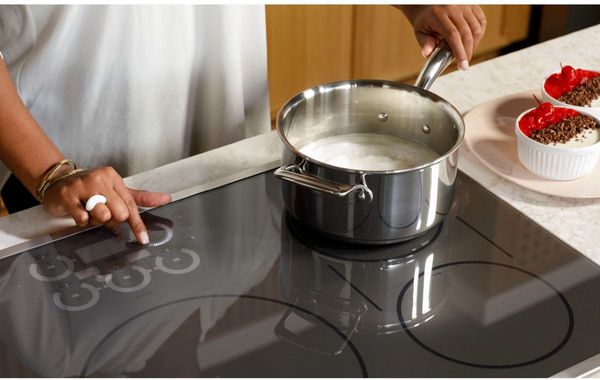
Shop Café 36" Stainless Steel Induction Cooktop
Dinner starts fast and finishes flawlessly with this Café induction cooktop that brings high-tech precision to everyday meals.
Sleek, responsive, and equipped with smart capabilities, it’s designed for serious home cooks who crave control and convenience.
The stainless steel trim and glide touch controls give it a premium look that complements modern kitchens. It’s especially useful for busy households that need quick results without sacrificing accuracy.
Top Features
- Precision Heat Control – Choose from 19 heat levels with intuitive white LED-lit touch controls for exact cooking results.
- Guided Cooking Technology – Syncs burner settings with step-by-step video recipes using a compatible smart pan.
- Easy-Clean Ceramic Surface – Smooth ceramic glass resists burnt-on spills and wipes clean with minimal effort.
GE Profile 36" Stainless Steel on Black Induction Cooktop
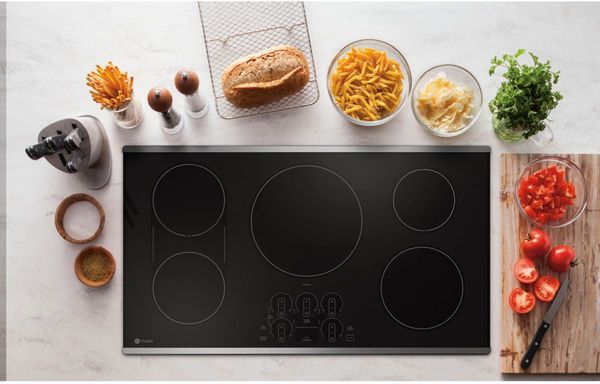
Shop GE Profile 36" Black Induction Cooktop
Smart technology meets fast, responsive cooking in this sleek GE Profile induction cooktop that turns up the heat.
Its glass surface and stainless accents give it a professional look, while the touch controls and Wi-Fi features make it a breeze to manage.
Designed with busy families and home chefs in mind, it gives precision and flexibility for everything from quick meals to delicate sauces. The guided cooking option is especially helpful for those who want to level up their kitchen skills.
Top Features
- Smart Connectivity – Built-in Wi-Fi links to SmartHQ and supports Chef Connect for seamless smart kitchen integration.
- Precision Temperature Control – Maintains steady heat between 100–500°F when paired with a compatible smart pan.
- Synchronized Elements – Combine two burners into one large heating zone—perfect for oversized cookware and griddles.
Choose the Cooktop That Matches Your Cooking Style
Understanding the differences in heating method and speed is key when deciding between induction vs radiant cooktop options. Induction cooking pros and cons include faster heating and precise temperature control, but it requires compatible cookware.
Radiant cooktops work with any pan but take longer to heat. Energy use and cost also vary. For example, induction models tend to be more energy-efficient, so they will save you money over time.
For personalized advice and to experience these cooktops firsthand, visit the Snow Bros showroom or call our experts, who can help you select the perfect fit for your kitchen needs.
Frequently Asked Questions
Induction cooktops require cookware made of magnetic materials such as cast iron or stainless steel with a magnetic base to generate heat efficiently. Non-magnetic cookware like aluminum, copper, or glass will not work unless they have a magnetic layer built into the bottom.
Induction cooktops can be worth the extra cost because they heat food faster and use energy more efficiently than traditional electric or gas cooktops. Their precise temperature control and safer cooking surface can also enhance cooking performance and kitchen safety, so they're a valuable investment for many households.
Replacing a radiant cooktop with an induction model is generally straightforward since both often fit into similar 30- or 36-inch cutouts and use the same 240-volt electrical connection. However, it’s important to check that your existing wiring supports the induction cooktop’s power requirements and to confirm the countertop cutout dimensions to ensure a proper fit.
Induction cooktops use electromagnetic fields to heat cookware directly, so the surface itself stays relatively cool and is safer to touch while cooking. However, the cooktop can become warm from residual heat transferred from the pan, so it’s important to be cautious and avoid touching areas under or near hot cookware.
This type of cooktop can produce a low humming or buzzing sound during operation, especially at higher power levels, due to the electromagnetic energy interacting with the cookware. Some models also have built-in cooling fans that generate noise to prevent overheating, but the sound is generally minimal and not disruptive.